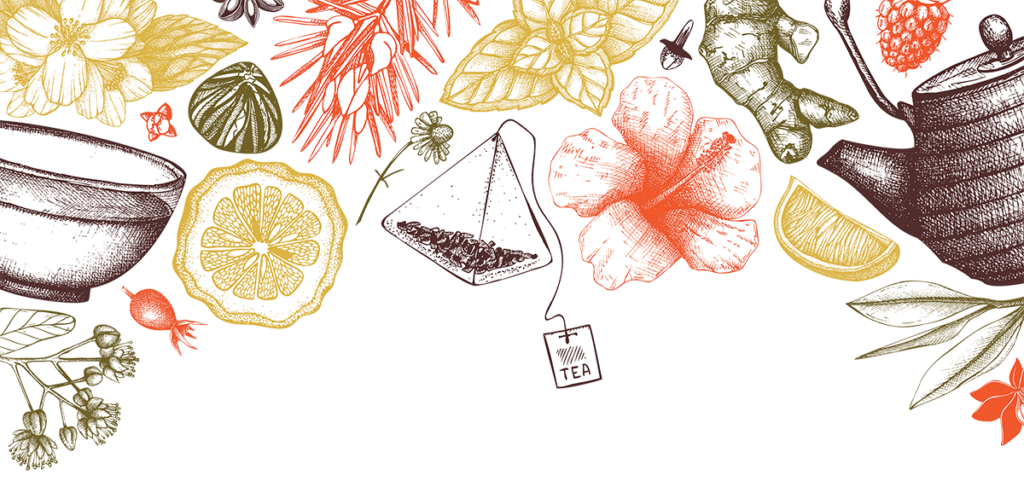 Herbal teas aren’t actually true teas because they are not made from the leaves and leaf buds of the tea plant, Camellia sinensis, as true teas are. Herbal teas are made from infusions of dried flowers, fruits, herbs, and/or spices, termed tisanes.1 True herbal teas do not naturally contain caffeine. Many herbal teas have been used medicinally for centuries for a number of health conditions.1 Is there scientific evidence to support medicinal use or health benefits of infused tisanes? Here we highlight some of the evidence supporting the health-promoting properties of five herbs that are commonly consumed in “tea” form.
Herbal teas aren’t actually true teas because they are not made from the leaves and leaf buds of the tea plant, Camellia sinensis, as true teas are. Herbal teas are made from infusions of dried flowers, fruits, herbs, and/or spices, termed tisanes.1 True herbal teas do not naturally contain caffeine. Many herbal teas have been used medicinally for centuries for a number of health conditions.1 Is there scientific evidence to support medicinal use or health benefits of infused tisanes? Here we highlight some of the evidence supporting the health-promoting properties of five herbs that are commonly consumed in “tea” form.
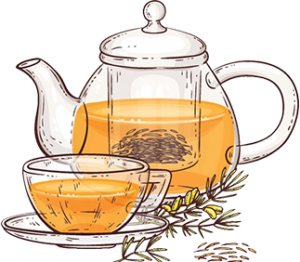 Rooibos Tea
Rooibos Tea
Rooibos tea is made from the fermented (red) or unfermented (green) leaves and stems of the Aspalathus linearis shrub, which is native to South Africa. Rooibos is considered a rich source of polyphenols with strong antioxidant properties—particularly the flavonoids aspalathin, which is unique to rooibos, and dihydrochalcone, which has only been found in a few other plants.2,4,5 Rooibos has been well studied, though most studies have used animal models. Research has demonstrated that the polyphenolic constituents of rooibos inhibit free radicals from attacking lipid cells and can modulate glutathione, a coenzyme that plays a big role in maintaining oxidative homeostasis in the body, and by way of these effects, research suggests rooibos has cardioprotective, anti-inflammatory, anticancer, and antidiabetic properties.2,4,5 A human study involving 40 participants at risk of heart disease demonstrated significant improvements in cholesterol (increased good cholesterol and decreased bad cholesterol) and oxidation reduction (redox) after drinking six cups of traditional/fermented rooibos tea daily for six weeks. Based on these results, the researchers proposed that regular consumption of rooibos could reduce risk of heart disease.3 Of note, other research has indicated that fermented (red) rooibos has less antioxidant properties than unfermented (green) rooibos, suggesting the fermentation process reduces the flavonoid content of rooibos tea, particularly aspalathin.2
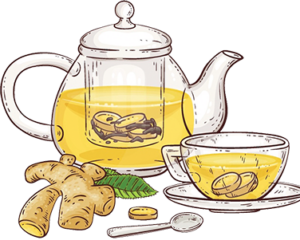 Ginger Tea
Ginger Tea
Ginger (Zingiber officinale) is a flowering, grassy-looking plant that spreads by way of underground horizontal stems known as rhizomes. As is the case when used as a culinary flavoring agent or in homeopathic medicine, ginger tea is made from the rhizome (or root) of the ginger plant. Ginger root contains gingerol, a phenol with antioxidant properties thought to be responsible for many of ginger’s health benefits. Research on ginger tea is lacking; however, there have been numerous studies on the ginger root itself. A recent systematic review analyzed data from 109 randomized, controlled studies on the health effects of ginger root.6 The authors of the systematic review reported that there is good evidence supporting ginger root as an effective treatment for chemotherapy-induced nausea and vomiting, nausea and vomiting of pregnancy, colorectal cancer, and muscular pain.6
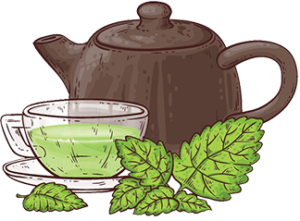 Peppermint Tea
Peppermint Tea
Peppermint tea is made from the fresh or dried leaves of the peppermint plant, one of many herbaceous low-growing shrub species in the genus Mentha, which is part of the Lamiaceae family. There are estimated to be as many as 13 to 24 species of mint, though the exact distinction between the species is unclear. In addition to its indigestion relieving properties, mint plants have exhibited other health benefits. Mint contains several flavonoids, primarily eriocitrin, luteolin, and hesperidin; polyphenols, primarily rosmarinic acid; and the volatile components of the essential oil, menthol and methone—all of which are thought to contribute to mint’s strong antimicrobial and antiviral, antioxidant, and antitumor properties, and to some degree antiallergenic properties, which are all well-supported in the literature.7 However, it’s important to note that most of these studies were done using the essential oil of mint. And while there have been a few studies on the peppermint leaf in human subjects, it does not appear that any research has been done specifically on peppermint tea in humans.7
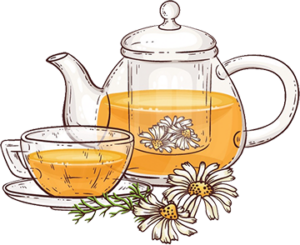 Chamomile Tea
Chamomile Tea
Chamomile tea is made from the dried flowers of the Matricaria chamomilla plant, a low-growing, shrubby plant with yellow-centered white flowers that resemble daisies. Chamomile flowers contain a variety of terpenoids and flavonoids that have known antioxidant properties. Some research suggests that chamomile might have several health benefits, including promoting heart health, improving immune system functioning, and protecting against some forms of cancers.9 A human study involving 80 women showed drinking chamomile tea was an effective therapy for severe menstrual cramps, mood issues associated with menstruation, and other related psychosocial problems.8
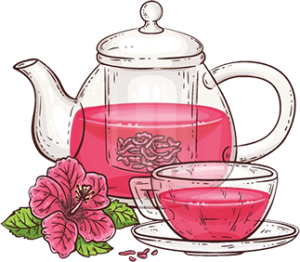 Hibiscus Tea
Hibiscus Tea
Hibiscus is a very large genus of woody flowering plants in the mallow family, Malvaceae. There are several hundred species of hibiscus, which are known for their large, showy flowers. Hibiscus tea (sometimes referred to as sour tea) is most commonly made from the petals and calyx, or sepals (the outer parts of the flower, often green and leaf-like, that enclose a developing bud), of the Hibiscus sabdariffa species. Hibiscus tea and extracts made from Hibiscus sabdariffa calyx have been shown to be effective in reducing hypertension and high cholesterol; these positive effects are thought to be due to the antioxidant effects of the anthocyanins found in hibiscus.10,11 A meta-analysis of five randomized, controlled trials (390 total participants) studying the effects of hibiscus on blood pressure showed significant positive effects on both systolic and diastolic blood pressure.10 In another meta-analysis, researchers collected and analyzed data from randomized, controlled animal and human trials studying the effects of hibiscus on high blood pressure and/or high cholesterol. Animal studies aside, there were a total of 10 randomized, controlled human studies that were analyzed. Results indicated that daily consumption of hibiscus calyx extracts or tea significantly lowered systolic and diastolic blood pressure in adults with pre-to-moderate hypertension and Type 2 diabetes. The authors also reported that over half of the RCTs showed that daily consumption of hibiscus tea or extracts had positive effects on cholesterol by reducing the bad cholesterol and increasing the good cholesterol. The authors were careful to point out that these results are limited due to the wide variability between studies in the manner of hibiscus administration (i.e., extract, powder, tea) and the strength of the doses. However, the results from lower-rated trials were comparable to those reported from high-rated trials.11
Bottom Line
The strong antioxidant properties of rooibos, ginger, peppermint, chamomile, and hibiscus have been demonstrated in numerous studies, which suggests that drinking infusions of tisanes from these herbs may boost your health in one way or another; however, it is important to note that not all of the studies on these herbaceous plants were done in humans, and not all studies specifically evaluated the herbs in tea form. Consult with a qualified healthcare professional to determine if regular consumption of any of these teas is right for you.
Sources
1. Harvard Health Publishing site. The health benefits of 3 herbal teas. 21 Oct 2021. https://www.health.harvard.edu/nutrition/the-health-benefits-of-3-herbal-teas. 19 Jan 2022.
2. Ajuwon O, Ayeleso AO, Adefolaju GA. The potential of South African herbal tisanes, rooibos and honeybush in the management of Type 2 diabetes mellitus. Molecules. 2018;23(12):3207.
3. Effects of rooibos (Aspalathus linearis) on oxidative strss and biochemical parameters in adults at risk for cardiovascular disease. Marnewick JL, Rautenbach F, Venter I. J Ethnopharmacol. 2011;133(1):46-52.
4. Ajuwon OR, Oguntibeju OO, Marnewick JL. Amelioration of lipopolysaccharide-induced liver injury by aqueous rooibos (Aspalathus linearis) extract via inhibition of pro-inflammatory cytokines and oxidative stress BMC Complement Altern Med. 2014;14:392.
5. Pantsi WG, Marnewick JL, Esterhuyse AJ, et al. Rooibos (Aspalathus linearis) offers cardiac protection against ischaemia/reperfusion in the isolated perfused rat heart. Phytomedicine. 2011;18(14):1220-1228.
6. Anh NH, Kim SJ, Long NP. Ginger on human health: a comprehensive systematic review of 109 randomized controlled trials. Nutrients. 2020;12(1):157.
7. McKay DL, Blumberg J. A review of the bioactivity and potential health benefits of peppermint tea (Mentha piperita L.)Phytother Res. 2006;20(8):619-33.
8. Jenabi E, Ebrahimzadeh S. Chamomile tea for relief of primary dysmenorrhea. Iranian J Obstetr Gynecol Infert. 2010;13(1):39-42.
9. Srivastava JK, Shankar E, Gupta S. Chamomile: a herbal medicine of the past with bright future. Mol Med Report. 2010; 3(6):895–901.
10. Serban C Sahebkar A, Ursoniu S. Effect of sour tea (Hibiscus sabdariffa L.) on arterial hypertension: a systematic review and meta-analysis of randomized controlled trials. J Hypertension. 2015;33(6):1119-1127.
11. Hopkins AL, Lamm MG, Funk J, Ritenbaugh C. Hibiscus sabdariffa L. in the treatment of hypertension and hyperlipidemia: a comprehensive review of animal and human studies. Fitoterapia. 2013;85:84–94.





